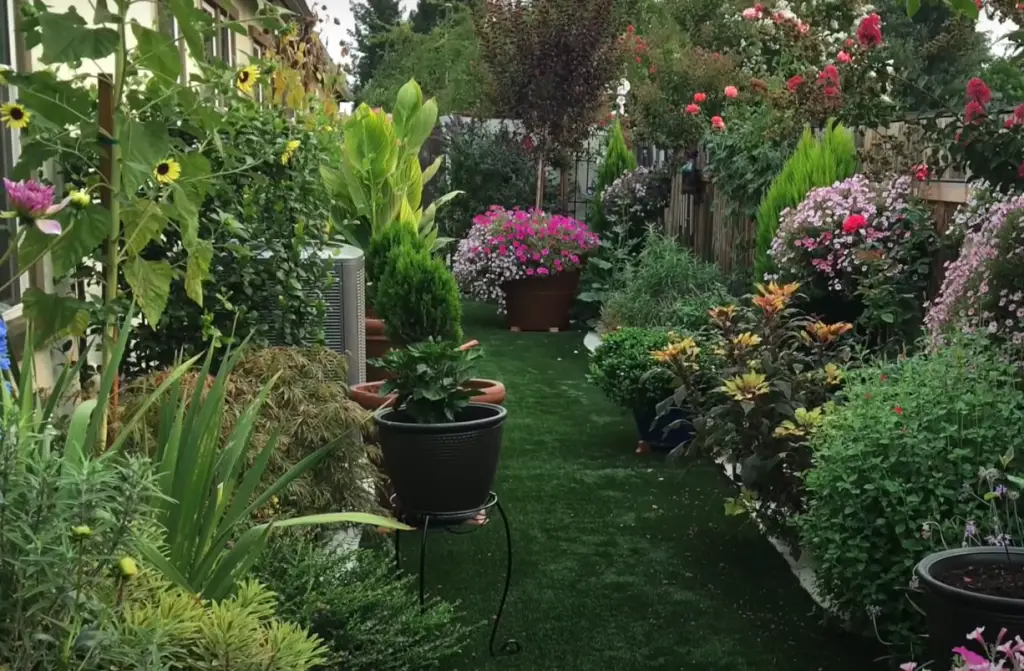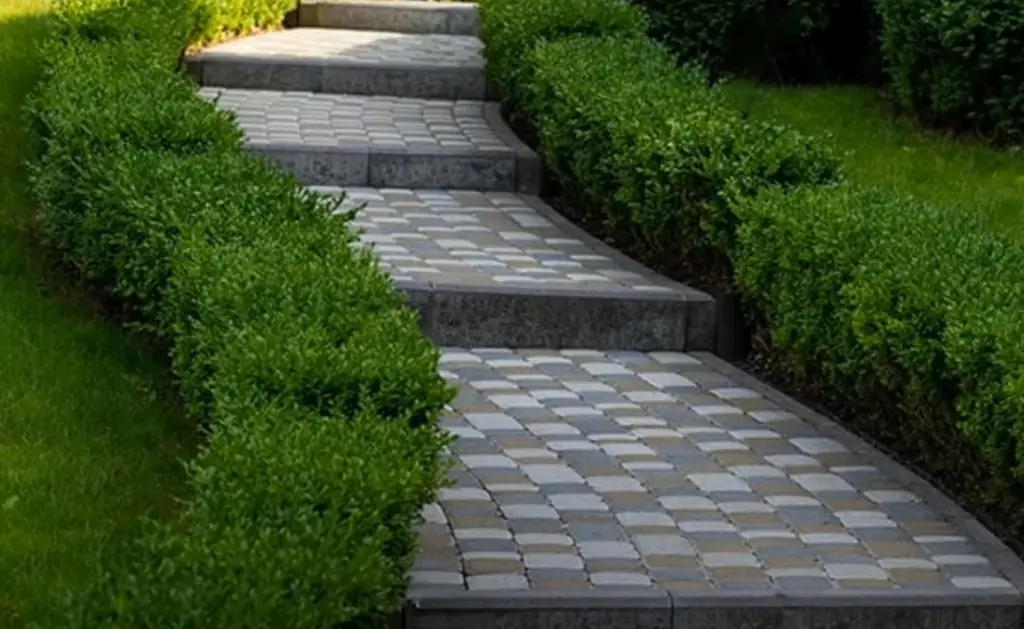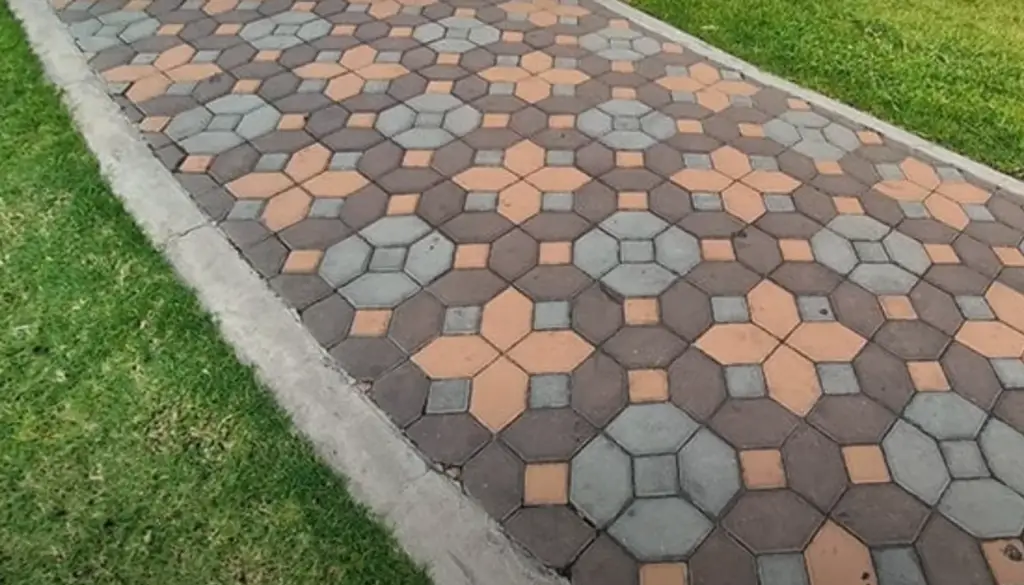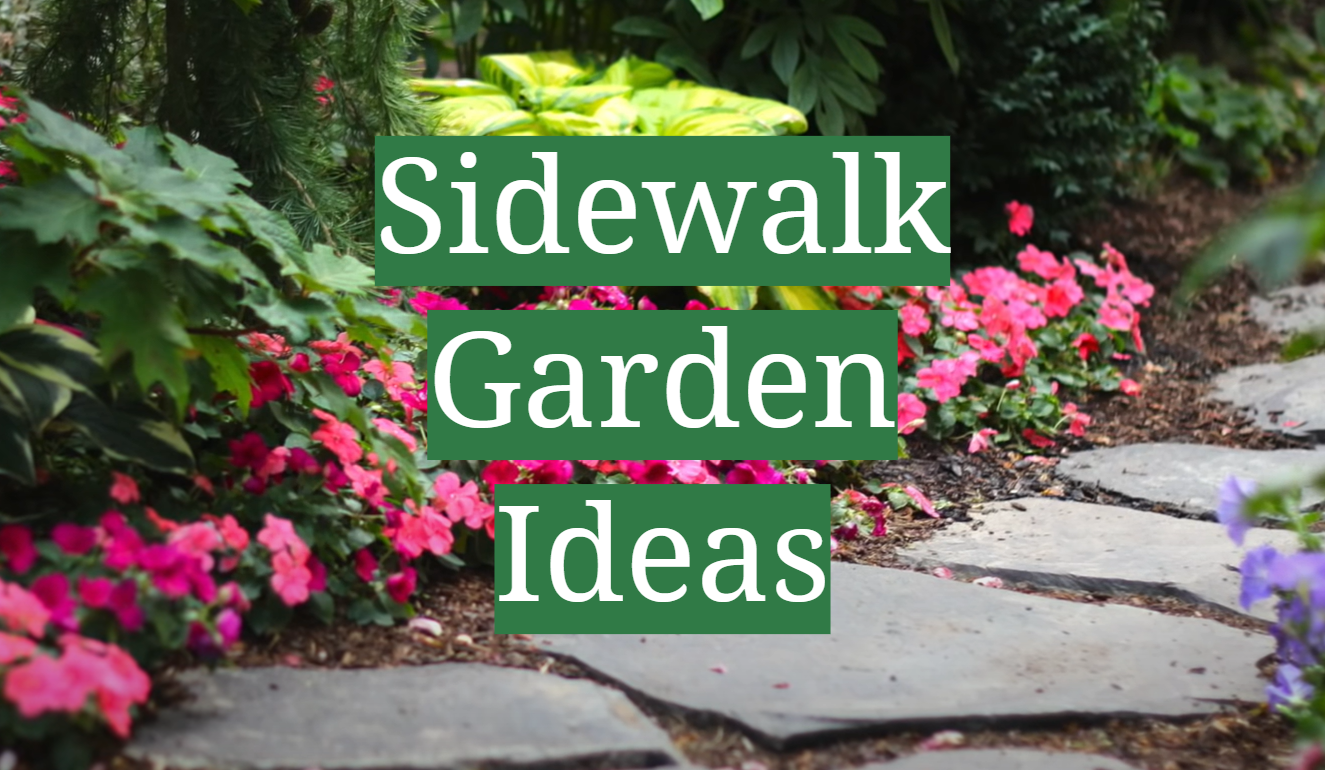Are you looking to spruce up your outdoor space without breaking the bank? If so, why not try creating a sidewalk garden! A colourful and inviting sidewalk garden is the perfect way to give your property a facelift while still keeping it affordable.
Whether you’re an experienced gardener or just want to add some touches of colour, these ideas will help get you started with creating an eye-catching visual display on your walkway.
From pots filled with annuals to incorporating native plants for a more sustainable approach; we’ve got suggestions for all skill levels that are sure to breathe new life into any entrance!
Use Layers in the Garden
Create Interest with Curves
Creating a garden along the sidewalk is much easier when you think of it as creating layers. Start with hardscaping, like stones or brick pavers, to define the shape of your space and provide an inviting walkway.

Once you have that set up, add in some edging or raised beds for additional structure. Then fill in those spaces with plants. This creates a layered effect that can really make your garden pop.
Make the Most of Your Space
When planning a sidewalk garden, it’s important to make the most of every inch of space. If you want to create an interesting design, thoughtful curves can really help draw the eye.
Try creating a few curves that lead in different directions and fill them with bright plants or colourful flowers. That will give your property a more dynamic look while also creating a sense of movement. [1]
Grow a Cutting Garden
If you have enough space, try growing a cutting garden. This will make your sidewalk garden look nice and you can cut the flowers inside the house. Pick plants that grow well in your area and need little work so you can enjoy them all season.
Decrease Your Yard Maintenance
If you’re looking to reduce your yard work, consider incorporating native plants into your sidewalk garden.
Plus, they are great for attracting beneficial bugs like pollinators since they provide a food source and habitat. [1]Our Best Curb Appeal Tips
Adding a sidewalk garden to your property is a great way to increase curb appeal and give your home some extra visual interest. To really make an impact, think about using bright colours and interesting shapes that will draw the eye.
You can also use edging or raised beds to create structure within the space and break up the monotony of a traditional garden, don’t forget to incorporate some native plants that are easy to care for and require little maintenance.
Make Your Yard Feel Bigger
If you have a small yard, adding a sidewalk garden can help make it look and feel. By creating an inviting path with colourful plants and interesting shapes, you can make outdoor space seem much larger than it actually is, it’s a great way to add some visual interest without taking up too much of your yard.
Delight Passersby with Fragrance
A sidewalk garden can also be a great way to add fragrance to your landscape. Planting varieties of flowers with different scents will create an inviting atmosphere that passersby can enjoy. You can even plant trees or shrubs with fragrant blooms or fruits for added interest.
Add Easy Elegance
Whether you’re a master gardener or just starting out, adding a sidewalk garden to your property is a great way to increase curb appeal and give your home some extra visual interest.

With the right plants and design elements, you can create an inviting space that will delight passersby with its fragrance, colour, and texture. So go ahead and add some easy elegance to your yard with a sidewalk garden!
Garden No Matter Where You Live
You don’t need a large yard to enjoy a beautiful garden. Even if you live in an urban area, there is likely some space along the sidewalk where you can add your own personal touch.
With the right plants and design elements, you can create an inviting oasis that will give passersby something to admire.
Sidewalk Garden Ideas
Garden Wall with Colourful Flowers
Create a garden wall by attaching planters to your fence or railing. Fill the planters with colourful flowers and greenery and you’ll have an instant splash of colour in your yard.
If you live near a busy street, this is also a great way to provide some privacy and sound insulation.
Thoughtful Curvilinear Garden Beds
Rather than having straight lines in your sidewalk garden, try adding some curves that will draw the eye.
Try creating a few curves that lead in different directions and fill them with bright plants or colourful flowers. That will give your property a more dynamic look while also creating a sense of movement. [2]
A Native Garden
You can make it easier to take care of your yard by planting native plants. Native plants grow best in the climate of your area and they don’t need much work once they are planted.
They also bring helpful bugs like pollinators because they have food and places for them to live.
Drought Resistant
If you live in an area with drought, adding drought resistant plants to your sidewalk garden is a great way to conserve water.
Drought-tolerant plants are specially adapted to survive in dry conditions and don’t require much maintenance once they are established. Plus, there are lots of beautiful options available that will give you a vibrant garden that uses less water.
Mailbox Street Side Garden
Transform your mailbox area into a mini garden with a few plants and accessories. You can add some bright flowers for colour, or create an herb garden to enjoy fresh herbs all year round. This is also a great way to give your mailbox area some extra personality.
Street Side Fence
If you have a fence that runs along the street, adding a garden in this area can give your yard something extra.
Plant some tall plants and vines along the fence to create privacy as well as add colour and texture. This is also a great way to create a sense of enclosure around your property.
A Garden Bed Around a Tree
If you have a tree in your yard along the sidewalk, create a garden bed around the trunk to draw attention to it.

Plant shorter plants like annuals or perennials so that they don’t block the view of the tree and add texture with mulch or gravel. This will give your yard an inviting feel and bring more life to the space.
A Separate Garden Street Side
If you have the space, create a separate garden bed along the sidewalk. Plant ground cover or shade-loving plants and add some seating for passersby to enjoy.
This is a great way to give your yard an extra layer of interest and show off your gardening skills.
FAQ
How do you plant around a walkway?
When planting around a walkway, it’s important to make sure the plants are spaced well so that they don’t interfere with the walkway. You can also add mulch or stone chips to keep weeds from growing in the area and make it easier to maintain.
What type of plants should I plant along a sidewalk?
When planting along a sidewalk, look for plants that are adapted to the climate of your area and don’t require much maintenance.
Ground cover plants like creeping thyme or hens and chicks can be a great choice as they provide texture and colour without taking up too much space. You can also plant drought-resistant perennials, shrubs, and trees along the sidewalk for added appeal.
How do I keep weeds out of a sidewalk garden?
The best way to prevent weeds in your sidewalk garden is to use mulch or stone chips around the plants. This will help to keep the soil moist and block out light that can encourage weed growth. You can also pull out any weeds that do grow as soon as you spot them.
How do you design a backyard layout?
Designing a backyard layout involves creating an overall plan that takes into account the size and shape of your space.
Start by making a list of all the elements you want to include in your yard, then draw out a rough sketch to get an idea of how it will look. Once you have a plan drawn out, you can start planning where each element will go and begin planting.
How do you garden around a patio?
When gardening around a patio area, look for plants that won’t interfere with the space such as ground covers or shrubs.
Add mulch or stone chips to keep weeds away and choose plants that will be easy to maintain. You can also add some seating areas so that you can enjoy your garden while relaxing on the patio.
What are the 7 principles of landscape design?
The 7 principles of landscape design are: balance, unity, scale and proportion, rhythm, emphasis, repetition and variety. These principles help to create a cohesive landscape design that is both aesthetically pleasing and functional.
By following these principles you can create a beautiful outdoor space that will last for years to come.
What is the cheapest rock to use for landscaping?
The cheapest rock to use for landscaping is crushed gravel or stone chips. They are inexpensive, easy to find and install, and can be used to create a variety of landscape designs. Plus, they are low-maintenance and last for many years without needing replacement.
What are the basic elements of landscape design?
The basic elements of landscape design include line, form, texture, colour and scale. Line refers to the pathways and shapes in your garden, while form is the overall shape of a space.

Texture creates visual interest by providing contrast between different plants or materials. Colour adds vibrancy to your garden, while scale is the size of elements relative to each other.
By incorporating these elements into your design, you can create a beautiful and functional outdoor space.
What types of materials can be used for landscape edging?
There are many different materials that can be used for landscape edging. Wood, metal, stone and plastic are all popular choices. Depending on the look you’re going for, you can choose from a variety of colours and styles to create a unique border for your garden or yard.
What type of plants are best for a low-maintenance garden?
When looking for low-maintenance plants, look for tough, hardy varieties that require little care. Perennials like daylilies and hostas are great choices as they come back every year without needing to be replanted.
Ground covers such as creeping thyme or hens and chicks are also low-maintenance options as they spread quickly and require little maintenance. Succulents, ferns and evergreens also make great additions to a low-maintenance garden.
What is the best way to care for plants in a sidewalk garden?
The best way to care for plants in a sidewalk garden is to water them deeply and regularly. Make sure to use a soil that drains well and check the plants frequently for signs of stress (such as wilting or dry leaves).
If the weather is too hot or dry, you may need to water your plants more often. Also, trim any dead or overgrown branches back and fertilise your plants a few times a year to keep them healthy. Finally, be sure to remove any weeds that may appear in your garden.
What plants should I avoid planting in a sidewalk garden?
When selecting plants for your sidewalk garden, be sure to stay away from those that are prone to spreading. Invasive species such as English ivy or vinca can quickly take over and become difficult to control.
Other plants that you should avoid include ones with deep roots (such as trees) or those that require a lot of maintenance (such as roses).
Additionally, be sure to choose plants that are suited for your climate and can thrive without too much fuss.
Why is it important to plan out a sidewalk garden before planting?
Planning out your sidewalk garden before planting is an important step in creating a successful outdoor space. By taking the time to lay out the design, you can ensure that all of your plants will get enough light and water and that there’s enough room for them to grow.
How can I create a beautiful landscape with limited space?
Creating a beautiful landscape in a small space is possible with some smart design choices. Start by adding visual interest with different colours and textures. You can also use plants that have multiple uses such as shrubs that provide screening or vines that cover fences and walls.

Finally, try vertical gardening to make the most of limited space. Hanging baskets and trellises can provide more growing area for plants without taking up too much room.
How can I add colour to a sidewalk garden?
Adding color to your sidewalk garden is easy with a few well-chosen plants or accessories. Flowers are the easiest way to add some life and vibrancy to your outdoor space.
Choose annuals for bright pops of color that you can switch out each season, or opt for perennials if you’re looking for more low-maintenance blooms.
Other accessories like painted furniture and colorful containers can also brighten up your garden without taking up too much space.
How do I make sure my plants get enough sunlight?
Making sure your sidewalk garden gets enough sunlight is essential for healthy growth. The best way to ensure that your plants are getting the sun they need is to arrange them in a spot that gets direct light for at least six hours a day.
If you have trees or buildings nearby, try moving your plants further away from them to maximise the amount of sunlight they receive. Additionally, if necessary, you can trim back any overgrown branches or shrubs that are blocking out the light.
What should I do about weeds in my sidewalk garden?
Weeds can quickly take over a sidewalk garden if not kept in check. The best way to deal with them is through prevention. Use mulch or other ground covers that can help prevent weeds from taking hold in your garden.

Additionally, if you do have weeds, it’s important to get rid of them as soon as possible by digging them up or pulling them out by hand.
Finally, make sure to fertilise your garden regularly and keep an eye out for new weeds to prevent them from spreading.
How often should I water my sidewalk garden?
How often you need to water your plants will depend on the climate and weather in your area. Generally, most plants will require at least an inch of water per week, but this can vary depending on the type of plant and the amount of sunlight they’re getting.
To make sure you don’t overwater, check the soil before you water and look for signs of wilting or browning foliage. Additionally, if your area is experiencing a lot of rain, it may be best to skip watering altogether.
What types of plants should I avoid planting in a sidewalk garden?
When choosing plants for your sidewalk garden, it’s important to avoid any that have invasive root systems or grow too large for the space. These types of plants can quickly take over your garden and crowd out other plants.
Additionally, make sure to research any potential pests or diseases that may affect the plants you’re considering so you can avoid them altogether. Finally, if you live in an area with extreme temperatures, make sure to choose plants that are hardy enough to survive the climate.
How do I create privacy with my sidewalk garden?
Creating privacy in your sidewalk garden can be accomplished with the right plants and accessories. Tall shrubs and trees can help block out sound and noise, while hanging trellises make for a great way to screen off unsightly views.
Vines are also an easy way to cover walls or fences for a more natural look. If you’re looking for something more permanent, lattice and pergolas can provide a full-on wall of privacy without taking up too much space.
Does my sidewalk garden need fertiliser?
Fertilizing your sidewalk garden is essential for strong, healthy plants. Depending on the type of plants you’re growing, you may want to opt for a slow-release fertiliser that will feed your plants over time or an organic option like compost or manure.
If you’re not sure which fertiliser is best, consult a professional and they can help you pick the right one for your plants. Additionally, make sure to follow all instructions on the package and water your plants after fertilising to ensure that it’s absorbed into the soil.
Do I need to prune my sidewalk garden plants?
Pruning your sidewalk garden plants is important for keeping them healthy and looking their best.
It’s best to prune when the plant is dormant in late winter or early spring. Additionally, be sure to use the right tools for the job and always wear protective clothing. Finally, make sure to clean up any debris afterward and dispose of it properly.
Can I grow fruits and vegetables in my sidewalk garden?
Yes, you can absolutely grow fruits and vegetables in your sidewalk garden. However, it’s important to choose plants that are suitable for the climate and space you have available.
Additionally, make sure to research any potential pests or diseases that may affect your plants before planting. Finally, be sure to water your plants regularly and fertilise them as needed.
With just a little bit of care, you can have a thriving sidewalk garden full of delicious fruits and veggies in no time.
Can I use containers in my sidewalk garden?
Yes, containers are a great way to add variety and interest to your sidewalk garden. When selecting containers, make sure they’re large enough for the plants you’re growing and that they have adequate drainage.

Additionally, be sure to choose containers made of materials that can withstand the elements such as plastic, wood, or metal. Finally, make sure to water your plants regularly and fertilise them as needed for healthy growth.
With the right containers and a little bit of care, you can create an eye-catching sidewalk garden in no time.
Does my sidewalk garden need to be in a specific location?
No, your sidewalk garden can be placed wherever you like. However, it’s important to select an area with plenty of sunlight and access to water for the best results. Additionally, make sure any plants you choose are suitable for the climate and space available.
Finally, if you’re using containers, make sure they’re elevated to allow for better drainage and air circulation. With the right location and plants, you can create a stunning sidewalk garden that will last for years to come.
Does my sidewalk garden need to be maintained?
Yes, your sidewalk garden will need regular maintenance in order to keep it looking its best. This includes pruning plants as needed, fertilising and watering regularly, weeding, and controlling pests or diseases.
Additionally, make sure to check the soil from time to time for compaction or other issues that could affect the health of your plants. Finally, make sure to clean up any debris from your sidewalk garden and dispose of it properly.
Can I incorporate plants in my sidewalk garden that attract wildlife?
Yes, incorporating plants into your sidewalk garden that attract wildlife is a great way to add biodiversity and interest. Consider selecting native plants that are known to attract birds, bees, butterflies and other beneficial insects.
Additionally, make sure to research any potential problems these plants may bring before planting them so that you can plan accordingly.
Finally, always choose plants that are suitable for the climate and space you have available, and make sure to water and fertilise them regularly for best results.
Is there anything else I should consider when creating a sidewalk garden?
Yes, there are a few other factors to consider when creating a sidewalk garden. For example, make sure to check for any local ordinances or regulations that may apply to your specific situation.
Additionally, if you’re using containers, make sure they’re large enough and have adequate drainage. Finally, research any potential pests or diseases that may affect your plants and plan accordingly.
Useful Video: Ideas for Skinny Side Yards! 🌿// Garden Answer
Conclusion
As you can see, there are many creative yet practical ways to transform your sidewalk into a beautiful and inviting garden. With just a bit of imagination, some life, and careful consideration for urban regulations and environmental factors, you can easily create a stunning sidewalk garden that will be the envy of your neighbourhood.
Don’t forget that it doesn’t have to be expensive; all you need is time and dedication to make it happen. So what are you waiting for? Make an effort this weekend and show everyone just how spectacular your sidewalk can become. Invite friends over, invite neighbours over, or simply enjoy the beauty of nature on your own while sipping a cup of tea in peace and quiet.
Either way, taking the initiative to create something special with what little space we have is always worth it – don’t forget to take lots of pictures to commemorate it! Thanks for joining me on this journey!
References:
- https://www.bhg.com/gardening/landscaping-projects/landscape-basics/sidewalk-garden-front-yard/
- https://tillydesign.com/blog/sidewalk-landscaping-ideas-to-improve-curb-appeal/










Leave a Reply
View Comments